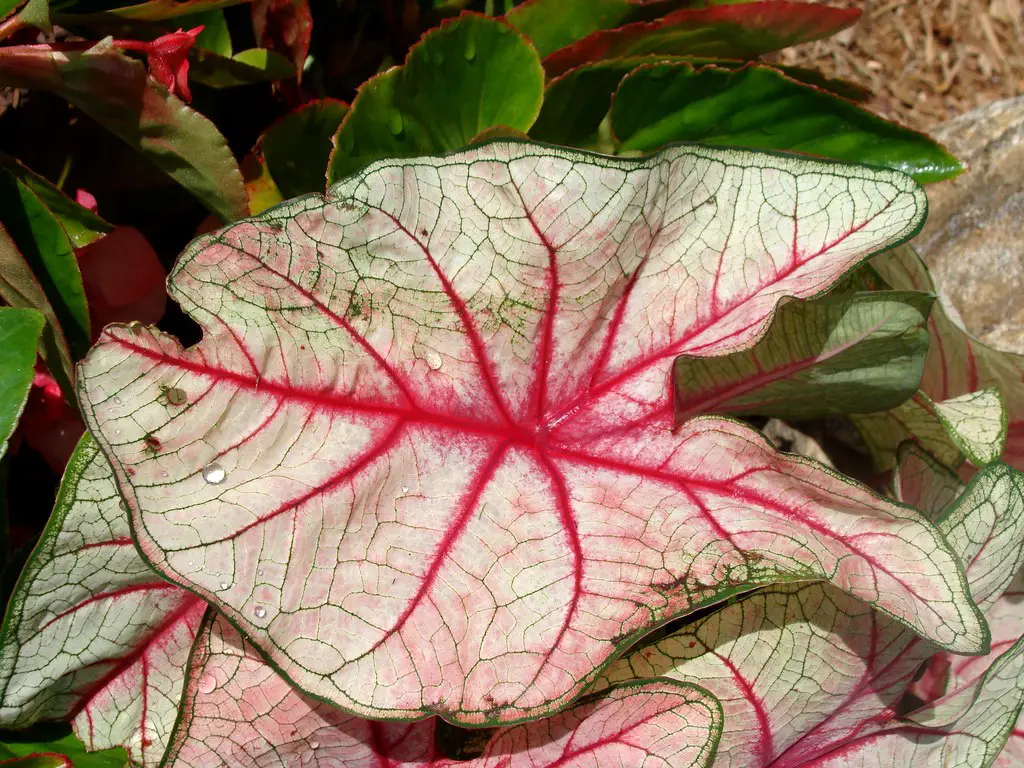Caladiums are tropical plants known for their colorful, heart-shaped leaves. They are a striking addition to any garden, indoor space, or container garden. The vibrant hues of red, pink, white, and green that pattern their leaves make Caladiums a standout in any setting. Native to South America, particularly the Amazon Basin of Brazil, these attractive plants have become popular worldwide.
The allure of Caladiums lies not only in their vivid appearance but also in their relative ease of care. They are commonly used in both landscaping and interior design, bringing a splash of tropical beauty to homes, gardens, and public spaces. Caladiums have a distinctive appearance, with each leaf being unique in its pattern and coloration.
Growing Caladiums successfully involves understanding their tropical origins and replicating those conditions as closely as possible. This means paying close attention to their requirements for light, moisture, and soil, as well as taking proper precautions against pests and diseases. Caladiums are primarily grown for their foliage, and they can be an exciting addition to any plant collection, whether you are a novice gardener or a seasoned expert.
| Attribute | Details |
|---|---|
| Common Names | Caladium, Angel Wings, Heart of Jesus |
| Botanical Name | Caladium bicolor |
| Family | Araceae |
| Plant Type | Perennial |
| Mature Size | 1-2.5 feet |
| Sun Exposure | Partial shade to full shade |
| Soil Type | Moist, well-drained, rich soil |
| Hardiness Zones | 9-11 |
| Native Area | South America |
Caladiums Care
Caladiums require special attention to their care, especially if you want them to thrive and maintain their vibrant colors. They prefer warm temperatures, high humidity, and well-drained, rich soil. Overly bright sunlight can wash out their colors, so finding the right spot that offers protection from intense midday rays is essential.
When planting Caladiums outdoors, consider placing them in an area with filtered light or where they will receive morning sun and afternoon shade. For indoor growing, placing them near a window with bright, indirect sunlight or using a fluorescent light can work well. Regular feeding and the right soil mix will also contribute to a thriving plant.
Light Requirement for Caladiums
Caladiums prefer indirect sunlight or partial shade. Direct sunlight can cause their beautiful colors to fade and may even scorch the leaves. Placing them in a location with morning sun and afternoon shade or near a bright window but out of direct sunlight is ideal.
Soil Requirements for Caladiums
Caladiums need well-draining, rich soil that retains moisture. A mix of peat moss, compost, and a little sand can create the perfect growing medium. Make sure that the soil stays damp but not soggy, as overly wet soil can lead to rot.
Water Requirements for Caladiums
Watering needs can vary depending on the humidity and temperature of the location. Keeping the soil consistently moist without overwatering is the key. In hot and dry conditions, more frequent watering may be necessary, while in cooler or more humid conditions, less frequent watering is needed.
Temperature and Humidity
Caladiums thrive in warm and humid environments. They prefer temperatures above 65°F, and they need a high level of humidity. Misting the leaves or placing a humidifier near the plant can help achieve the necessary humidity.
Fertilizer
Feed Caladiums regularly with a balanced liquid fertilizer during the growing season. A slow-release granular fertilizer can also be used at the time of planting. Avoid over-fertilizing, as this can lead to leggy growth and fewer leaves.
Pruning Caladiums
Pruning is not typically required for Caladiums, but removing dead or yellowing leaves can keep the plant looking its best and help prevent disease.
Propagating Caladiums
Caladiums can be propagated by dividing the tubers. Simply separate the tubers, ensuring each piece has at least one growing point, and replant in the appropriate soil.
How To Grow Caladiums From Seed
Growing Caladiums from seed is rarely practiced, as it’s a slow and difficult process. Most people prefer to propagate Caladiums through tuber division or purchase them as bulbs or plants.
Common Pests & Plant Diseases
Spider Mites
Spider mites can be controlled by regularly misting the leaves or using insecticidal soap.
Root Rot
Overwatering can cause root rot. Ensuring proper soil drainage can prevent this issue.
Common Problems With Caladiums
Leaves Losing Color
This can occur if the plant receives too much sunlight. Adjusting its location to provide more shade can resolve this problem.
Drooping Leaves
This can be a sign of underwatering or low humidity. Increase watering and consider using a humidifier.
Pro Tips
- If growing Caladiums indoors, consider using a grow light to maintain vibrant colors.
- Plant Caladiums alongside other shade-loving plants for a visually pleasing garden display.
- Caladiums go dormant in winter, so reduce watering and allow the soil to dry slightly during this period.




